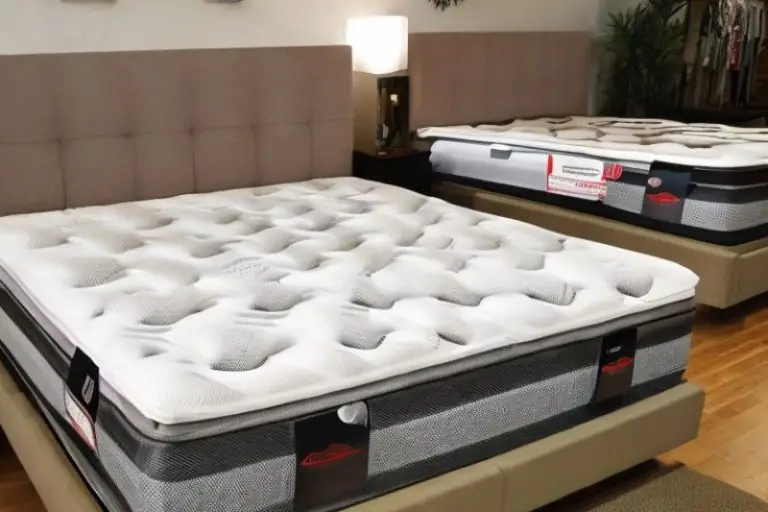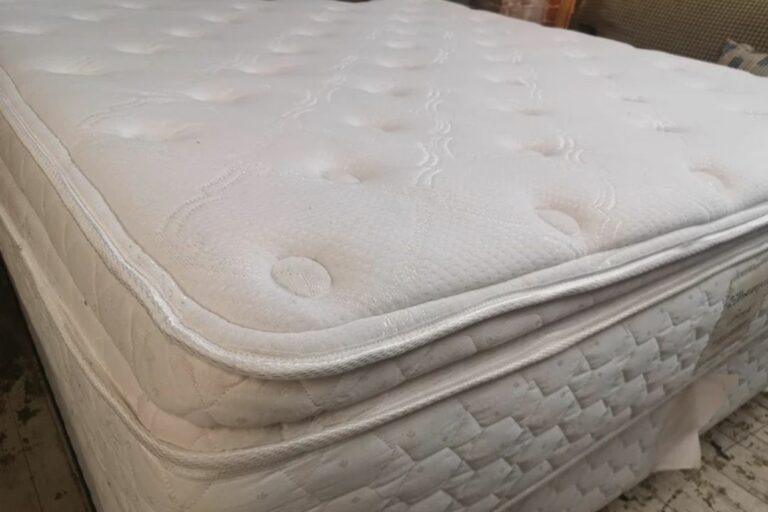Can Mattress Springs Break? (REVEALED)

Though mattresses are designed to provide comfort and support for many years, mattress springs can sometimes break.
This article will look into what causes mattress springs to fail and how you can prevent it from happening.
We’ll also discuss the practical solutions available should your bed suffer from a broken spring, helping to ensure that you get a restful sleep every night!
Can mattress springs break?
Yes, mattress springs can break. In fact, in a study of 51 mattresses from 2013-2014, it was found that a staggering 25% of them had broken or damaged springs.
Of those broken springs, 65% were located on the sides and edges of the mattress where most people sit down. The remaining 35% were scattered throughout the rest of the mattress surface.
It’s important to note that when selecting your next bed, you should opt for one with high quality components such as pocketed coils or foam to ensure longer lasting durability and performance.
What is the lifespan of a mattress spring?
The lifespan of a mattress spring depends on several factors including the quality and type of spring used. Generally, a good-quality mattress with springs that are either pocketed or interconnected can last up to 8 years, depending on how it is cared for.
Innerspring mattresses use steel coils as support system which are then surrounded by cushioning materials like foam and fabric. The overall durability of these types of mattresses is determined by the gauge (thickness) of the wire used for the coils, as well as the number of turns in each coil.
The higher quality mattress models tend to have thicker wire and more turns per coil, making them last longer than cheaper models that use thinner wires or fewer turns in their coils.
Pocketed or interlinked springs work together to provide greater support across an entire bed surface area rather than just directly beneath your body weight. This helps extend its life significantly since it distributes pressure evenly over a larger surface area instead of concentrating it at one point leading to quicker wear and tear over time.
Additionally, using high-density foam layers above the springs provides extra protection from sagging within a shorter amount time compared to traditional boxspring beds without foam layers above them.
Overall, with proper maintenance such as regular vacuuming and rotating your mattress every 3 months you can certainly expect your mattress’s springs will last up to 8 years if not longer!
How can Mattress Springs Break?
Mattress springs are strong and durable, but they can still break over time. The two most common causes of mattress spring failure are wear-and-tear or improper use. Wear-and-tear is the result of longterm use that eventually leads to fatigue in the metal coils.
After years of supporting a body’s weight while sleeping, these metal springs will gradually become weak and lose their elasticity, resulting in broken or bent mattress springs. Improper use can also cause damage to mattress springs.
If a person puts too much pressure on one spot for an extended period of time, this could lead to sagging as well as stressed and broken individual coils.
Furthermore, if children jump on mattresses with greater force than recommended by the manufacturer then it may cause significant damage to the coils that make up a bed’s support system.
In any case where mattress springs have been damaged due to either wear-and-tear or improper use, it’s important for owners to replace them at once so sleepers remain comfortable and supported throughout the night without risk of further damage occurring down the line.
Causes of Broken Bed Mattress Springs:
There are a few common causes of mattress springs breaking. One of the most common is wear and tear over time. The natural process of aging can cause the springs to weaken and eventually break, even if they were originally well-crafted by a manufacturer.
A second culprit for broken mattress springs is poor support from either an inadequate foundation or box spring supporting the mattress. Without proper support, the weight from sleeping on it may be too much strain for the bed’s structure to bear and result in broken springs.
Another possible cause could be placing heavy items on top of your bed such as mattresses that sit directly upon slatted frames, couches or futons which can add too much weight and put pressure on specific areas causing breaks in certain spots around the mattress’s perimeter.
Finally, company manufacturing defects can also lead to premature breakdown due to improper design or materials used during production leading to faulty construction later down the line when customers begin using their beds more frequently with regular sleep cycles over time.
Reasons to Replace Damaged Bed Springs:
One of the primary reasons to replace damaged bed springs is comfort. When mattress springs are broken or worn out, they can cause an uncomfortable sleeping surface and leave you with areas of uneven support.
This can lead to back pain, discomfort, and difficulty getting a good night’s sleep. In addition, these issues will only get worse over time if the springs remain in bad condition. Another reason for replacing damaged bed springs is safety.
Spring coils that have become bent can poke through the fabric and create sharp edges that could potentially cut skin or snag clothing.
Mattress spring damage may also be indicative of other structural problems within a mattress such as weak seams or poor construction which could pose additional risks to your wellbeing while using the bed.
Finally, replacing old bed springs can reduce noise when people move on the mattress during sleep.
Loose coils often make creaking noises which may disrupt sleep for both parties in a shared bedroom environment; this problem can easily be solved by swapping out worn-out components with new ones that fit properly and are securely attached to their frame base.
Solutions for Avoiding Bed Mattress Spring Damage:
When it comes to avoiding mattress spring damage, the best solution is prevention. To prevent damage and extend the life of your mattress springs, follow these tips: First, make sure to rotate or flip your mattress regularly to even out wear.
This can help stop coil fatigue and keep them from becoming permanently bent out of shape. Regularly flipping a bed can also help maintain comfort levels and reduce sagging over time.
Additionally, check for any signs of regular wear-and-tear like bumps or lumps in the fabric covering that may indicate weakened support beneath it.
Second, keep your bed away from direct sunlight as this will dry up natural oils found in mattresses which can lead to premature aging and breakdown over time when exposed regularly.
Furthermore, try using a protective pad on top of the mattress such as a memory foam layer or other cushioning material that can act as another barrier between you and those uncomfortable coils beneath you while sleeping at night.
Finally, buy quality beds with good warranties so that if anything does go wrong you are covered by their generous return policies should something break down after use.
Cheap beds often have fewer internal support elements than more expensive counterparts do – making them less durable against everyday wear-and tear -so investing in one with better build quality may be worth it for longer lasting comfort day after day.
Tips for Replacing a Broken Mattress Spring:
Replacing a broken mattress spring is not an easy task, but it can be done. Here are some tips that may help you:
- Firstly, make sure to identify the type of spring used in your mattress. Different types of springs require different tools and methods for replacement. If you don’t know what kind of spring is used in your mattress, consult the manufacturer or retailer from whom you purchased it.
- Secondly, purchase quality replacement parts for your mattress. It’s important to use high-quality springs when replacing them as low-quality replacements may break more easily than expected and will shorten the lifespan of your new mattresse significantly.
- Thirdly, follow any instructions provided by the manufacturer or retailer closely while replacing the springs so as to put together all components properly and avoid any unexpected damages or malfunctions caused by incorrect installation process.
- Additionally, using proper tools such as a box cutter and hammer will ensure smooth installation procedure without causing additional damage to other components on your bed frame or headboard/footboard assemblies..
- Finally, inspect all connections after completing the repair job just to make sure everything is working correctly before using it again. Keeping up with regular maintenance checks will ensure that future repairs can be prevented from happening due to early detection of worn out components on your bedframe assembly system.
How long do mattress springs last?
When it comes to mattress springs, one of the most common questions asked is how long they can last. Generally speaking, mattress springs will last between seven and ten years before they begin to wear out and need replacing.
However, this lifespan can vary depending on several factors such as the quality of materials used in the construction of the spring system, how much weight is placed on it over time and if proper care has been taken with regards to rotating or flipping the mattress regularly.
In order for a consumer to get a good indication as to whether their existing bed’s springs are still in working condition or not, there are few telltale signs that should be watched for.
These include sagging along certain areas of the bed due to uneven pressure being applied from sleeping bodies over time; an increase in noise coming from coils when lying on them; noticeable dips appearing around where people usually sleep; or increased difficulty when moving around during sleep due to added stiffness from broken components within a coil system.
Ultimately, understanding how long your current bed’s springs may last requires knowledge about what kind of material was originally used during manufacture – which may be difficult without knowing who made it – as well as being aware of any specific maintenance needs associated with its type.
With regular attention given towards ensuring that all parts remain intact while also using appropriate preventative measures like turning/rotating whenever possible, you should be able extend your mattress’s life expectancy beyond its expected range by following these guidelines throughout ownership period.
When you can feel the springs in your mattress?
When you can feel the springs in your mattress, it is usually a sign that something has gone wrong. The springs inside mattresses are designed to be hidden and act as support for the mattress without being felt or heard.
If you can feel them when you lie down or move around on your bed, then either the springs have become worn out over time, meaning they need replacing; or there is an issue with your current mattress’s construction which requires attention.
The longevity of a mattress varies depending on its quality and how often it’s used. Generally speaking, higher-end mattresses should last between seven to ten years before needing any major repairs or replacements – this includes checking for broken springs too!
Low-quality products might not even last half as long before feeling uncomfortable due to their weak coils and inadequate materials. If you do find yourself with a broken spring in your mattress then don’t worry!
Most companies offer warranties that cover eventualities such as these so if within the warranty period simply contact them explaining what has happened and they will advise best on how to replace it free of charge (or at least heavily discounted).
Otherwise if outside of this window then individual replacement coils may still be achievable but likely at cost price – so make sure to shop around for the best deal first!
Conclusion:
In conclusion, the answer to the question of whether or not mattress springs can break depends on a variety of factors.
Generally speaking, mattress springs are very durable and will last for many years. However, if you have an older model or use your bed frequently, it is possible that eventually some of the springs could start to wear down over time and eventually break.
It is important to be aware of this potential issue when using any type of mattress so that you can replace them as needed.
Additionally, regular inspections should be done in order to make sure all components are functioning properly and no damage has occurred.
With proper care and maintenance, it is unlikely that your mattress springs will ever need replacing but there’s always a chance they could fail at some point in time.






